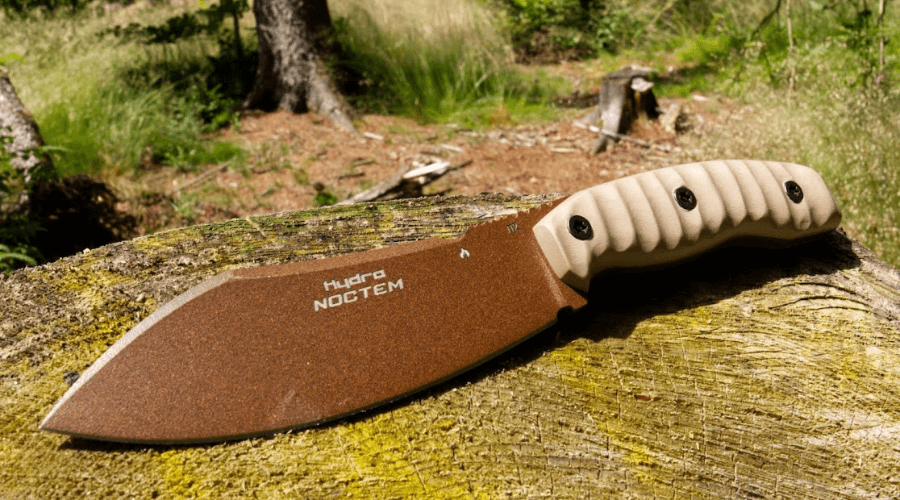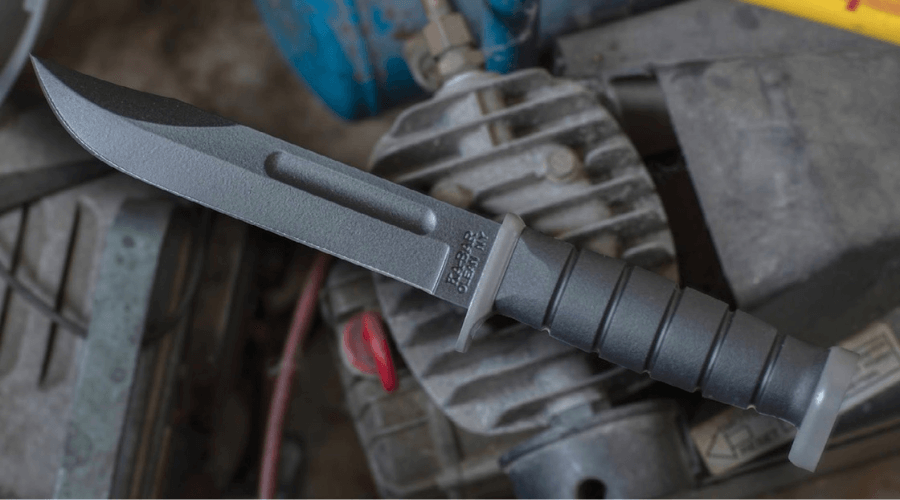How (not) to handle a knife?
The knife belongs to the basic elements of (not only) outdoor and survival equipment and has a very wide range of uses. The best knife is the one we have with us when we need it. However, this alone is not enough. To ensure that your knife always works perfectly and that you can rely on it 100%, you need to take care of it regularly and also use it properly. What are the biggest mistakes to avoid? We'll cover all of these in this article!
The saying "every good man carries a knife" sounds perhaps a little too like a cliche, but no one has ever expressed it better. Whatever type of knife we choose for our particular purposes, we should always keep it sharp. That's the first principle we'll come back to. But there are more principles about how to (not) handle a knife. Let's take a closer look at them.
1. Only cut with the knife
At first glance, this seems logical - a knife is a tool that is inherently designed to cut (unless it's a special category of sport throwing knives). Of course, in a pinch it can be used more multifunctionally, but at your own risk. Because if you use a knife for anything other than cutting, you risk not only destroying it, but potentially injuring yourself and/or those around you. So for multi-functional use, get a proper multitool instead, it will be safer.
A knife is not a screwdriver, saw, crowbar or hammer. Its blade is designed to have even pressure applied to it. If you apply one-sided pressure, point or otherwise, a piece of the blade (or the entire blade) may break off or the knife may become blunt, bent, twisted or otherwise (usually) irreparably damaged. And given that a good quality knife is not exactly the cheapest thing, that would be a shame.
A broken blade piece can fly off at a higher speed when too much pressure is applied, causing an unpleasant injury. One more note on this topic - always only cut with a knife material that is softer than the blade itself. Of course, the harder the material, the sooner the blade becomes blunt and the sooner it needs maintenance.

In order to be able to rely on your knife 100% of the time, you need to take care of it regularly, but also use it in the right way. The ANV M200 HT is pictured. Source: Rigad.
2. Beware of moisture and corrosion
Most knives, or rather their blades, are made of stainless steel. But just because it's stainless doesn't mean it can't corrode. Every type of steel is only stainless to a certain extent. Therefore, never expose the knife to prolonged moisture. Of course, sometimes you have to work with it in the rain or maybe you need to cut a piece of fruit - such things don't harm the knife. Provided you always dry it thoroughly after use.
For a similar reason, it is not advisable to clean the knives under water, but rather always just wipe with a damp cloth. Especially those knives that are equipped with various pins or closing mechanisms. Once in a while it is also advisable to take care of the knife in other ways, for example with a knife cleaning spray. If the knife has a wooden handle, it is recommended to treat it regularly with linseed oil or genuine beeswax.
Moisture and corrosion are not so damaging to the blade itself, but to the pivots, locking mechanisms and places where metal joins with other material (for example, if the blade is a full-tang design). What is definitely detrimental to the blade, however, is washing it in the dishwasher. Not only can other objects (such as the plastic parts of the dishwasher) be scratched during the washing process, but at the same time, for example, two blades can "rub" against each other, losing their texture and sharpness. In addition, if the dishwasher is delayed in starting, more aggressive foods can damage the blades and make them dirty.
One more note on this topic - corrosion, even minor, superficial corrosion, does not only harm the knife itself, but also the objects we cut with it. Especially when it comes to food, which can easily become contaminated by corrosion, and it is certainly not advisable to get bits of metal in with your food. And if we are cutting some "delicate" material, then it is a pity to get it irreversibly dirty through corrosion.

Always keep your knife sharp. A properly sharpened knife performs its function better and is safer to use. Pictured is the Noctem knife from Hydra Knives. Source: Rigad.
3. Maintenance of screws
The handle is often attached to the blade (especially in the full-tang design) by screws or rivets. The screws may tend to loosen from time to time. Therefore, it is advisable to continuously check their tightness and, if necessary, tighten them with a suitable tool. There are also special thread adhesives that will keep the screws in place longer. It is certainly advisable to check the tightening of screws, not only because a knife with a loose screw can become unstable and potentially dangerous, but also because a lost screw and the subsequent search for a suitable replacement is certainly not a pleasant affair.
Maintaining the pins and rivets is another matter - but we would leave this work to the experts if we were you. Similarly, if your knife gets damaged in any other way, definitely don't try to fix it yourself unless it's really a trivial matter, but rather leave it to the specialists so you don't cause yourself any unnecessary injuries.
4. A blunt knife is more dangerous
In this paragraph we would like to disprove the myth that a dull knife must be safer than a sharp one, because you can't cut yourself with one. Wrong. Once you dull the knife, you have to exert more force and push harder for all the work you do with it. This, however, increases the likelihood that it will slip out and you will injure yourself badly.
Therefore, it is important to keep the knife in good condition. Sharpening a knife can be done in a variety of ways, the most primitive being hand sharpening, which takes practice. Because hand sharpening gives us nothing to maintain the angle of the blade against the whetstone, we have to adjust the angle manually throughout the sharpening process, which can be quite difficult for beginners. A machine grinding system, on the other hand, will keep the angle the same throughout the entire sharpening process, so it is suitable for anyone who is not confident in this.
And then there's the temporary solution in the form of broaching sharpeners, which can be used to sharpen the knife just roughly. Or sharpening steel, which don't sharpen, they just flatten the blade. You can read in detail about sharpening knives and other tools in one of our earlier articles.

The best knife is the one you have with you when you need it. On the picture KA-BAR 1211. Source: Rigad.
5. Suitable storage
Naturally, you need to store your knife properly to ensure it lasts as long as possible. We don't even need to mention that you should keep your knives out of the reach of children. Knives should ideally be stored in a drawer, but you should get an organiser for them. Definitely do not store knives loose in a drawer. This could lead to further unnecessary injuries if you cut yourself on a knife, for example when pulling out other equipment.
If you wash the knife by hand together with kitchen utensils, dry it thoroughly and store it separately in the place designated for it. Don't leave it in the drainer with the other dishes, but take the extra half minute to take the knife by itself exactly where it belongs.
Naturally, there are also knife racks that allow for vertical storage. This is also an option, especially if you have multiple knives. But we're talking about outdoor knives rather than kitchen knives, and such a knife should have its own special place of honour among other equipment. If you have a fixed blade knife, don't store it in the sheath for long periods of time, but outside of it.
6. Safety measures
A knife is not just a tool, it can also be a weapon. Therefore, when handling it, it is necessary to observe certain safety measures to avoid injuring yourself and those around you. If you do injure yourself with a knife, make sure you immediately carry out basic treatment with the help of a first aid kit. If the injuries are more extensive, then seek medical attention without delay.
Never make any sudden movements with the knife, do not run or climb with it. If you drop the knife on the ground, wait until it lands, even if it means damaging it. Never catch it in flight, you could cut yourself. You may be able to buy a new knife, but a cut on your hand can have permanent consequences. Similarly, don't throw a knife to anyone, even with a sheath or blade cover.
Most of us learned as children that a knife is always used to cut away from the body of oneself and others, and that if you hand a knife to someone, it is hand to hand and handle first. When working with a knife, you should have enough light (a headlamp can help in the evening and at night) so that you can see the work well and again avoid unnecessary injury. And last but not least, never use a knife to repair mains-connected (and preferably even those unplugged ones) electrical equipment. Apart from any possible electric shock, you could damage your knife in such a situation.
Readers are further interested

























































































































